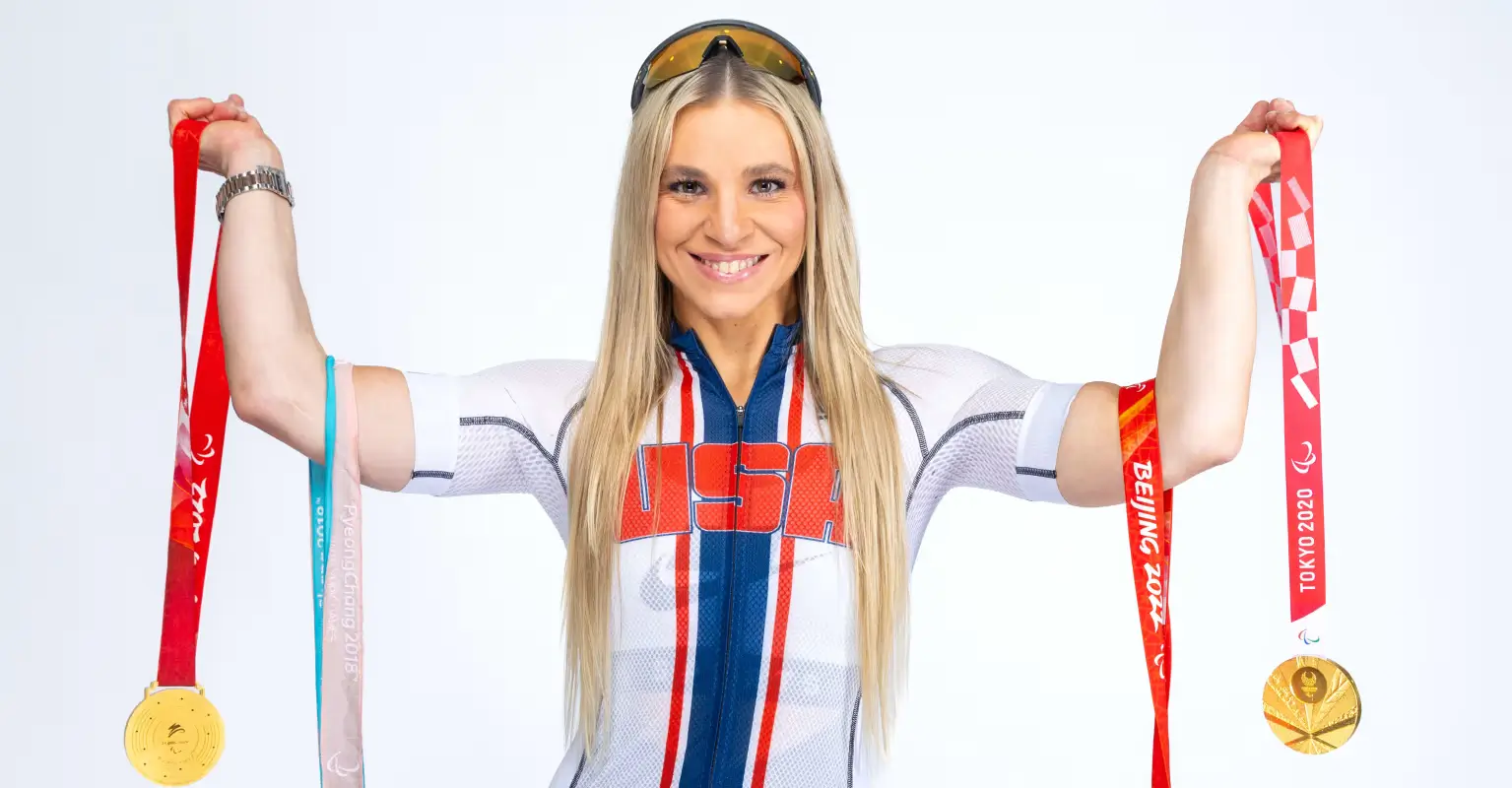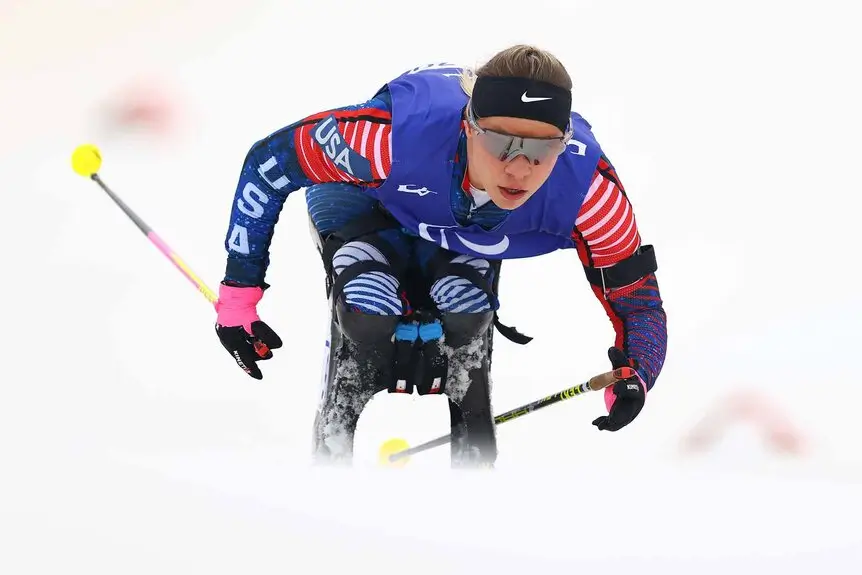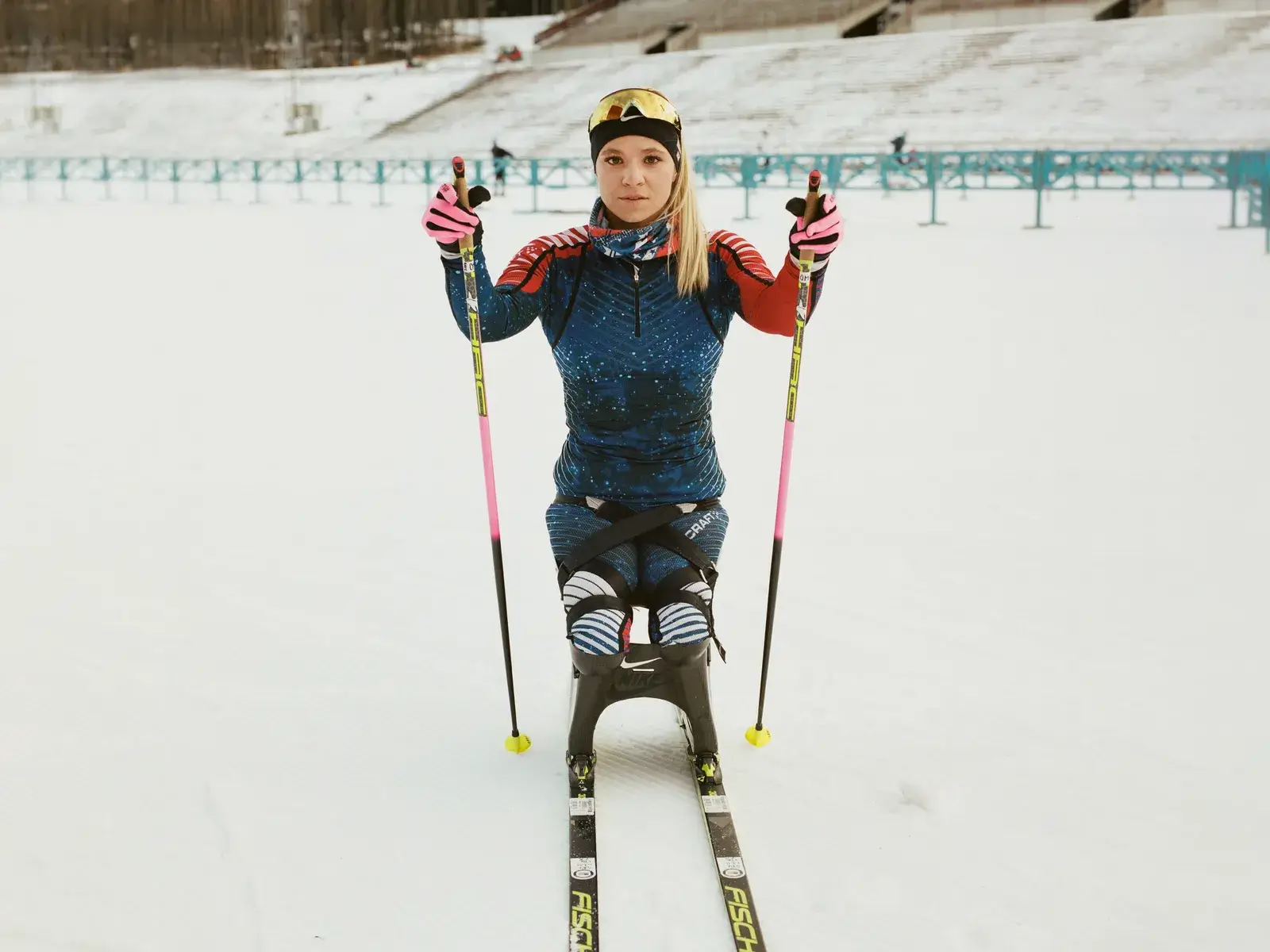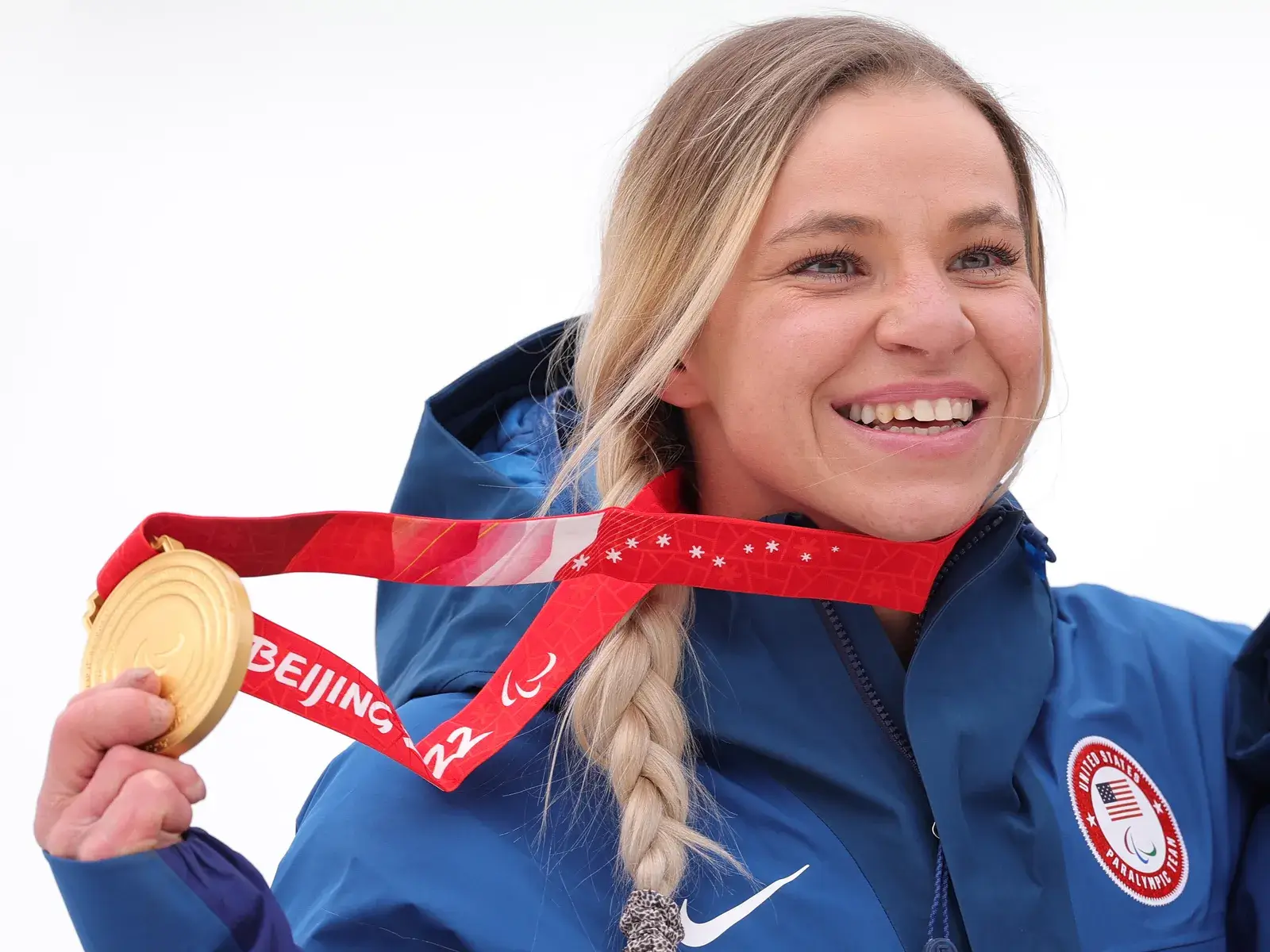Oksana Masters is a true hero. She is a Paralympic athlete who has won 19 medals across four sports: rowing, cross-country skiing, biathlon, and para-cycling. Born in Ukraine in 1989, three years after the Chernobyl disaster, Oksana faced many challenges from birth. She had no thumbs, webbed fingers, and legs without tibias.
She spent her early years in orphanages before being adopted by an American family at age seven. In the USA, she had surgeries to amputate her legs. But Oksana didn’t let her challenges stop her. She found strength in sports. At 13, she started rowing and won a bronze medal at the 2012 London Paralympics.
She then tried winter sports like skiing and biathlon, winning more medals. Later, she took up para-cycling and won even more golds. Oksana’s story shows that with hard work and courage, anything is possible like Indian medal tally is increasing.
From Ukraine to the USA: Oksana’s Early Life

Oksana Masters was born in Ukraine, a country far from the USA. Her birth was tough. She had birth defects, like missing thumbs and legs without tibias. These problems came from the Chernobyl disaster in 1986. Chernobyl was a nuclear accident that made many people sick. Oksana’s mom was affected, and so was Oksana.
She grew up in orphanages. These were places for kids without families. Oksana moved between three orphanages. Life was hard. She felt alone and unloved. Other kids bullied her because of her hands and feet. But Oksana was strong and never gave up.
At age seven, her life changed. An American woman, Gay Masters, adopted her. Gay took Oksana to the USA. There, Oksana got help. She had surgeries to fix her legs. Doctors amputated her legs below the knees. This helped her use prosthetics, or fake legs.
Gay also introduced Oksana to sports. She saw that Oksana loved to compete. Sports gave Oksana a new family. It made her feel strong and happy.
Oksana’s early life was full of pain. But it also made her tough. She learned to fight for herself. This spirit helped her become a great athlete. Her journey from Ukraine to the USA is amazing. It shows how love and support can change a life.
Born in the Shadow of Chernobyl
Oksana was born in Khmelnytskyi, Ukraine, in 1989. This was three years after the Chernobyl disaster. Chernobyl was a nuclear power plant that exploded. It spread radiation, making many people sick. Oksana’s mom was near Chernobyl when it happened.
This caused Oksana’s birth defects. She had six toes, webbed fingers, no thumbs, and legs without tibias. These made it hard for her to move. But Oksana was brave. She didn’t let her body stop her. She learned to do things her own way. Her story shows how strong she is.
Life in Orphanages and Adoption
Oksana spent her first seven years in orphanages. These were not happy places. She felt unwanted. Other kids were mean to her. They didn’t understand her differences. But Oksana stayed strong. Then, Gay Masters came into her life.
Gay was from the USA. She adopted Oksana and took her to America. In the USA, Oksana got better care. She had surgeries to help her walk. Gay also showed her sports. Oksana loved rowing first. It made her feel free. Adoption gave Oksana a new start. It helped her become the inspirational athlete she is today, because it is all about gender equality.
Discovering Sports: Rowing to the Paralympics
Sports changed Oksana’s life. At 13, she tried rowing. Rowing is a sport where you sit in a boat and use oars to move. Oksana loved it. On the water, she felt free. She didn’t think about her legs or hands. She just rowed.
Oksana trained hard. She got better and better. Soon, she was one of the best rowers in the world. In 2012, she went to the London Paralympics. The Paralympics are games for athletes with disabilities. Oksana won a bronze medal in rowing. It was her first Paralympic medal. She was so proud.
But Oksana didn’t stop there. She wanted more. After rowing, she tried other sports. She wanted to see what else she could do. This made her a multi-sport champion.
Rowing taught Oksana many things. It showed her she could do hard things. It also made her famous. People started to know her name. They saw her as a hero. Oksana’s story inspired many. She showed that anyone can succeed, no matter their challenges.
Rowing was just the start. It opened the door to bigger dreams. Oksana’s journey in sports was just beginning. She would go on to win many more medals. But rowing will always be special. It was where she found her strength.
First Steps in Rowing
At 13, Oksana tried rowing. It was hard at first. But she loved it. Rowing made her feel strong. It didn’t matter that she had no legs. She used her arms to row. She got better quickly. Soon, she was winning races. Rowing gave Oksana confidence. It made her believe in herself. She started to dream big. She wanted to go to the Paralympics. And she did. In 2012, she won bronze in London. It was a big moment. Rowing changed Oksana’s life. It showed her what she could do.
Paralympic Debut in London 2012
The 2012 London Paralympics were special for Oksana. It was her first time at the big games. She competed in rowing. She won a bronze medal in the women’s single sculls. This is a race where you row alone. Oksana was so happy. The medal meant a lot. It showed she could be a top athlete. After London, Oksana wanted more. She didn’t want to stop at rowing. She wanted to try new sports. This made her a multi-sport athlete. Her debut was just the beginning. She would go on to win many more medals.
Conquering Winter Sports: Skiing and Biathlon
After rowing, Oksana tried winter sports. She started with cross-country skiing. This is a sport where you ski long distances. Oksana loved it. She trained hard and got very good.
In 2014, she went to the Sochi Winter Paralympics. She won silver in the 12km race and bronze in the 5km race. Both were in the sitting category. This means she skied while sitting down. Oksana was amazed. She had only been skiing for two years!
But she didn’t stop there. In 2018, at the PyeongChang Winter Paralympics, she did even better. She won two gold medals: one in the middle-distance race and one in the sprint. She also won silver and bronze. Oksana was now a star.
Oksana then tried biathlon. Biathlon is skiing and shooting. You ski fast, then stop to shoot a gun. It’s very hard. But Oksana did it. In 2022, at the Beijing Winter Paralympics, she won gold in the 6km biathlon sitting.
Oksana’s success in winter sports is amazing. She went from rowing to skiing to biathlon. Each time, she won medals. This shows how talented she is. It also shows her hard work. Oksana never gives up. She always tries new things like players in 2024 event.
Her story inspires many. She shows that disability sports can be exciting. She proves that anyone can be great, no matter their challenges. Oksana is a true Winter and Summer Paralympics champion.
Transition to Cross-Country Skiing
After the 2012 Paralympics, Oksana wanted more. She tried cross-country skiing. It was new and hard. But she loved it. She trained every day. Soon, she was one of the best. In 2014, at the Sochi Paralympics, she won two medals: silver and bronze. This was big. It showed she could do winter sports too.
Skiing made Oksana even stronger like D. It also made her more famous. People started calling her a multi-sport champion. Oksana was proud. She knew she could do anything. Skiing opened new doors for her.
Gold Medals and Records
Oksana’s best skiing moment was in 2018. At the PyeongChang Paralympics, she won two golds. One was in the middle-distance race, and one was in the sprint. She also won silver and bronze. This made her a legend. No one had done this before. Then, in 2022, she tried biathlon. Biathlon is skiing and shooting. Oksana won gold in the 6km race. She was so happy. Winning in biathlon was hard. But Oksana did it. Her medals show how great she is. They also show her love for sports.
Pedaling to Glory: Para-Cycling Success

Oksana loves trying new sports. After skiing and biathlon, she tried para-cycling. Para-cycling is biking for people with disabilities. Oksana used a handcycle. This is a bike you move with your arms.
She started cycling after the 2016 Rio Paralympics. She trained hard and got very good. In 2020, at the Tokyo Paralympics, she won two gold medals. One was in the time trial, and one was in the road race. Both were in the H5 category. This is for cyclists with leg disabilities.
Oksana’s cycling success was amazing. She had only been cycling for a few years. But she was already the best. Her wins made her even more famous. People called her a cycling star.
Cycling showed Oksana’s versatility. Versatility means being good at many things. Oksana is good at rowing, skiing, biathlon, and cycling. This is rare. Most athletes focus on one sport. But not Oksana. She loves challenges.
Her cycling medals added to her total. Now, she has 19 Paralympic medals. Nine are gold, seven are silver, and three are bronze. This makes her one of the most decorated Paralympic athletes ever.
Oksana’s story in cycling is inspiring. It shows that age doesn’t matter. She started cycling later than other sports. But she still won. Her success proves that it’s never too late to try something new.
Taking on a New Challenge
Oksana always wants more. After skiing and biathlon, she tried para-cycling. Cycling was new to her. But she wasn’t scared. She trained hard. Soon, she was racing. In 2020, at the Tokyo Paralympics, she won two golds. One was in the time trial, and one was in the road race.
This was huge. Cycling made Oksana even better. It also made her happier. She loves trying new things. Cycling showed her she can do anything. It also showed the world how talented she is.
Winning Gold in Tokyo 2020
The 2020 Tokyo Paralympics were special for Oksana. She competed in cycling. She won gold in the time trial and road race. Both were in the H5 category. This is for cyclists with leg disabilities. Oksana was so proud. Winning in cycling was hard. But she did it. Her golds made her total nine. This is a lot! Oksana’s cycling success showed her skill. It also showed her love for sports. She never stops trying. Tokyo was just another step in her journey. But it was a big one.
Beyond the Medals: Oksana’s Impact and Legacy

Oksana Masters is more than medals. She is an inspiration. Her story touches many lives. She shows that anything is possible. Even with challenges, you can succeed.
Oksana speaks at schools and events. She tells her story. She wants to help others. Many kids look up to her. They see her as a hero. Oksana makes them believe in themselves.
She also wrote a book. It’s called The Hard Parts: A Story of Courage and Triumph. The book tells her life story. It talks about her struggles and wins. Many people read it. They learn from it.
Her work goes beyond sports. It changes minds. People see disabilities differently now. They see strength and courage.
Oksana’s legacy is big. She is a Ukrainian-American athlete who did great things. But she is also a voice for change. She shows that adaptive sports can be fun and exciting. She proves that disability doesn’t mean weakness.
In the future, Oksana will keep inspiring. She will keep competing too. But her real win is helping others. That’s what makes her a true champion.
Inspiring the Next Generation
Oksana loves helping others. She visits schools and talks to kids. She tells them her story. Many kids have disabilities too. They feel alone. But Oksana shows them they’re not. She says, “You can do anything.” Her words give them hope. Oksana also wrote a book. It’s about her life. Kids read it and feel stronger. They see that hard work pays off. Oksana is a hero to many. She makes them believe they can win too.
Advocacy and Public Speaking
Oksana does more than compete. She fights for people with disabilities and wants them to have chances for big events. She talks about inclusion which means everyone is welcome. Oksana wants sports to be fair for all. She also works with groups like Team USA.
They help athletes with disabilities. Oksana’s voice is loud. It makes people listen. Her work changes lives. It also changes how people see disabilities. Oksana is a leader. She shows that athletes with disabilities can be great.
Conclusion
Oksana Masters is amazing like Arthur Bauchet. Her journey is one of courage and strength. From Ukraine to the USA, she faced many challenges. But she never gave up. She turned pain into power.
Oksana won 19 Paralympic medals. Nine are gold, seven are silver, and three are bronze. She did this in four sports: rowing, skiing, biathlon, and cycling. No one else has done this.
But Oksana is more than medals. She inspires millions. Her story shows that anything is possible. With hard work, you can achieve your dreams.
Oksana also helps others. She speaks at schools and writes books and fights for people with disabilities.
Oksana’s legacy is big. She is a multi-sport champion. But she is also a hero. Her story will live on. It will touch lives for years to come. Oksana Masters is truly unstoppable.

